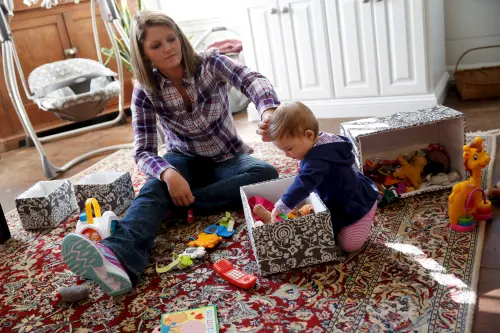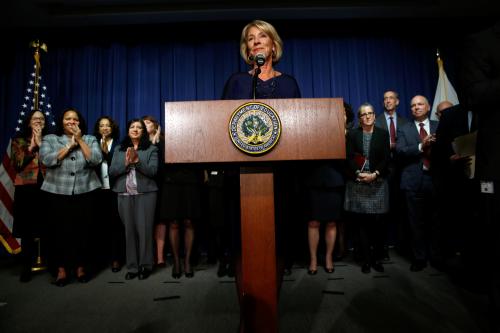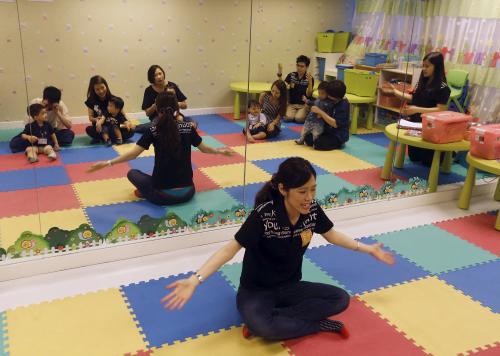In 1964, President Lyndon B. Johnson coined the phrase War on Poverty while introducing legislation designed to combat a 19 percent poverty rate that he declared unacceptable. He believed that federal programs had an important role in reducing poverty. Today, we are seeing a new War on Poverty that will harm, rather than help, the poor by cutting funding for low-income families leaving them with no safety net and little hope of a brighter future. As the holiday season of generosity ends and we look to 2018, we need to ensure that the effective policies that affect and target our most vulnerable children are strengthened—not cut.
Over the past few months, two actions by Congress demonstrate that they have little intention of helping low-income families. First, the recently passed tax cut bill will do little to provide relief to low-income households, with analysis projecting that the richest 20 percent of American households will receive two-thirds of the bill’s benefits in 2018. Even the last-minute amendment prompted by Senator Marco Rubio to expand the Child Tax Credit would only result in a modest $300 average annual increase in tax returns for low-income families who are already paying more than $2,000 a year for childcare.
Second, Congress has allowed federal funding for the Children’s Health Insurance Program (CHIP) to expire, potentially affecting the 9.2 million children enrolled in the program. The program is funded through block grants, so states will exhaust their existing funds at different points in 2018: 16 states at the end of January and another 21 by end of March.
Childhood poverty remains a persistent and daunting problem in the United States. A report by the Organization for Economic Cooperation and Development (OECD) ranked the U.S. 35th out of 40 member nations in addressing childhood poverty. One in every five children in the U.S. is living below the poverty line and poverty is the single best predictor of life trajectories. Recent research by the Children’s Hospital of Philadelphia showed that as early as 5 weeks of age, children born into poverty had less grey matter brain volume (i.e., the part of the brain where information is processed) than their middle-income counterparts. In addition, living in poverty exerts its impact throughout life in poorer health outcomes like chronic illness and heart disease decades later.
Poor children are also more likely to suffer from mental health issues like toxic stress, anxiety, and depression. Moreover, these early physical and mental challenges manifest themselves in grade retention, early dropout rates, teen pregnancy, and increased risk for incarceration. Collectively, society cannot afford the lost productivity and the increased social expenditures associated with crime and poor health. Lifetime societal costs for each cohort of 16- to 24-year-old youth who aren’t enrolled in school or employed is projected to be in the trillions of dollars.
Disparities between middle- and lower-income families are not new. What is new is the accelerating rate at which the poor are getting poorer and the rich, richer. Social mobility in the U.S. is among the lowest in wealthy industrialized countries.
High-quality early childhood education programs for children from low-income families show benefit-cost ratios of 7:1—meaning for every dollar we invest society saves roughly $7 in social service costs.
Thankfully, we have evidence that we can begin to reverse this by investing in early childhood programs. Universal high-quality preschool, for example, shows that children who attend good early education programs are more likely to stay in school and to have strong educational outcomes. A new study from Tulsa, Oklahoma showed that universal pre-K had effects on math achievement, enrollment in honors courses, and grade retention that endured through middle school. Home visiting confers similar benefits with high-quality programs reducing child abuse and neglect, decreasing pre-term births and low-birth weight, as well as increasing school readiness and high school graduation rates. Free lunch programs reduce food insecurity and improve nutritional intake, positively influencing health and reducing obesity rates. There is also evidence that adequate nutrition improves student cognition and behavior and that these lunch programs are actually “helping kids do better in school” by allowing them to pay attention and not worry about where their next meal will come from.
These programs give children from low-income families a fighting chance to be part of our great society. And the irony is, the more we invest in them, the more it benefits us. For example, high-quality early childhood education programs for children from low-income families show benefit-cost ratios of 7:1—meaning for every dollar we invest society saves roughly $7 in social service costs. We simply cannot turn a blind eye towards these children or take away the support systems that give them a chance to become happy, healthy, and productive citizens.
As 2017 rolls into 2018, we must restore public decency by putting programs into place that help families help themselves. After the Salvation Army volunteers pack up their bells and red kettles, we simply cannot write off 20 percent of our population or forget their woes; we must support early childhood programs. Let’s start by fully funding CHIP.
The Brookings Institution is committed to quality, independence, and impact.
We are supported by a diverse array of funders. In line with our values and policies, each Brookings publication represents the sole views of its author(s).










Commentary
Funding childhood poverty programs is key to social mobility
December 28, 2017